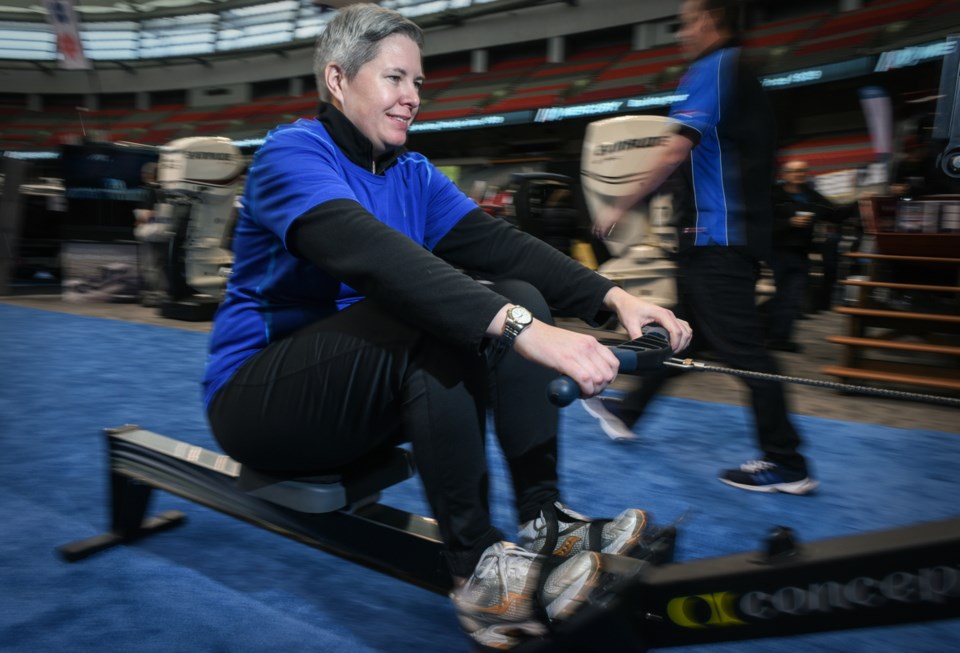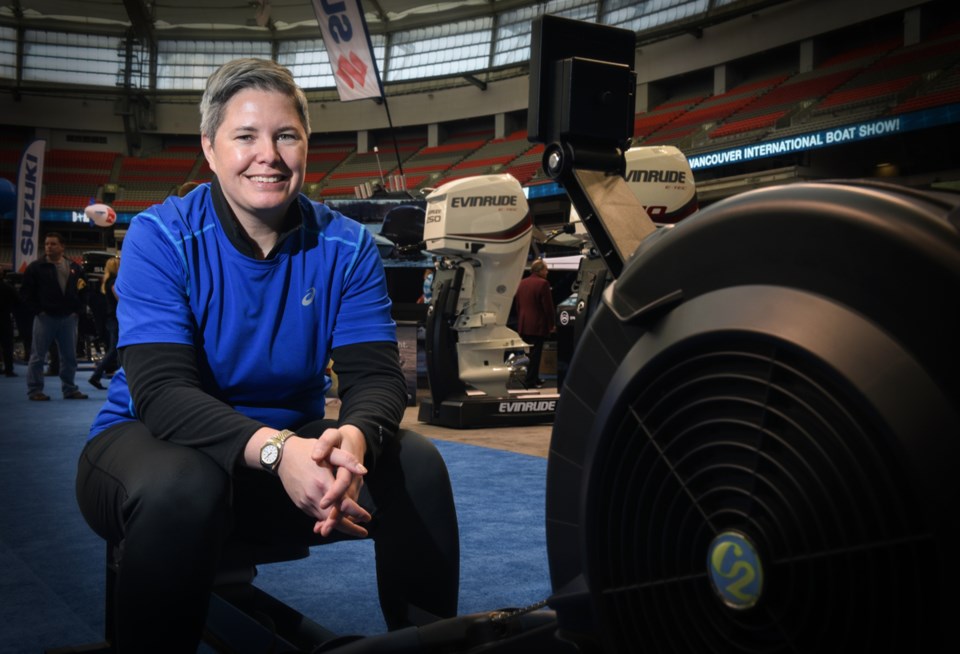Perched on the tiny seat of a stationary rowing machine on the ground floor of the International Boat Show at B.C. Place, Brenda Robbins was a quarter of the way to her destination when “mind over matter” simply wasn’t enough to power her anymore.
Starting at 10 a.m. Jan. 20, she started gunning for a Guinness World Record. To meet it, she’d have to stay on that seat, rowing until Saturday night. Rowing for the next 81 hours.
“I learned that the psychological challenge is even more challenged than I ever imagined,” she said after she stopped her row the next day at noon. “Upon reaching that physical limit when pain is setting in and sleep deprivation is having its effects, the will to keep going was the biggest limit I hit.”
Robbins, who grew up in land-locked town in Manitoba and now calls the West End home, said the feeling was surreal. She couldn’t will her body forward. She rowed for 26 hours, setting a women’s record in the effort to row nearly three times longer.

“When the physical challenge hit its limit — pain, exhaustion, dizziness — I was surprised that I wasn't better able to overcome it psychologically, to tell my mind to push through it,” she said.
Daring to be great
In the tremendous effort, Robbins moved at a slow pace but nonetheless rowed nearly 175 kilometres at seven km/h.
But in fact, her record row is just the warm-up for a much more significant feat. This summer, Robbins will attempt to cover nearly 4,000 km — 2,400 miles as a straight line but more like 3,000 miles because of wind, waves and open water — from California to Hawaii as part of a four-woman team in the Great Pacific Race. If successful, they will be the second women’s foursome to complete the feat and Robbins will be the first Canadian to row across the Pacific Ocean.
Naturally, she and the Daring Greatly Crew want to break a record and set the benchmark as the fastest women’s team to make the journey. They will aspire to cover between 50 and 70 miles each day. Robbins has yet to meet her teammates in person.
“When I first got interested in ocean rowing, the record didn’t appeal to me at all,” she said. “I just wanted to get on the ocean and pursue my own journey across. But you learn about the records and other people who are making attempts, and it’s like, I can do that. They are goals within a goal. There is something to that.”
Oceanwise
In their own words, the Great Pacific Races is “the biggest, baddest human endurance challenge on the planet.” Open row boats with international crews of two or four people compete in this epic journey. The modern, Western history of open ocean rowing dates to 1896 when a 10,000 cash prize spurred two New Jersey fisherman to test themselves on the Atlantic. The first successful crossing of the Pacific was recorded in 1971.
Robbins is preparing to spend between 30 and 80 days at sea without sails or engines, rowing for two hours and resting for the next two before picking up the oars for two more hours and then repeating until her team reaches Waikiki Beach.
“You can always adjust it as the team feels is needed though the longer a break you take, the longer you will be rowing as well. This is conventional and seems to be the tried-and-true method of all the ocean teams.
“I’m very motivated,” she said. “Right away, it was in my head that I wanted to do this.”
She learned about the Great Pacific Race following its inaugural year in 2014 and immediately set out to learn everything she could.
Robbins launches out of Jericho Sailing Club, mostly to paddle and kayak, and keeps a stationary rowing machine in her apartment. She planned a solo row of the Atlantic, but left that to pursue the Great Pacific Race.
She will try to consume roughly 5,000 calories a day through high-caloric freeze dried food. During her 26-hour indoor row, she ate salmon, fruit, coconut oil on crackers, and protein smoothies. She was able to take a 10-minute break every hour.
On the ocean, there will be little reprieve, but getting there is one of the biggest challenges.
“They say that, even hard than rowing the ocean, is getting prepared for the race financially and logistically,” said Robbins.
Rowing for blood
She is fundraising through GoFundMe for her transportation to California and for supplies during the trip. Her goal is $45,000 and she is also raising money to donate to the Leukemia and Lymphoma Society of Canada.
Robbins’ father died in 2015 of acute leukemia.
“He was really easy to get along with even when it came to having a terminal illness, he never complained and he was a really positive and supportive person,” she said.
“I feel that he always had confidence in me. Whatever I set my mind to, I would follow through on and do it safely and to the best of my ability.”
Follow Robbins’ preparation and race on her blog at rowforblood.ca.
Twitter: @MHStewart



